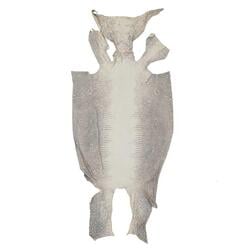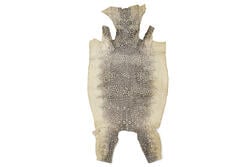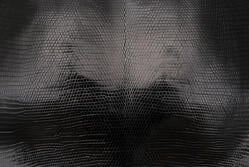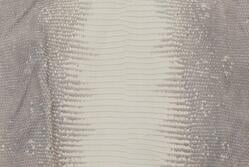Each lizard skin project is different. How do you know what kind of skin to buy, how to size the skins, and how to get the appropriate cut for your project? That's one of the hardest parts of the process, so we'd like to walk you through it.
The Cut
The first decision you get to make is front cut or back cut. It’s a bit counterintuitive: back cut means the skin is cut down the back so you get the belly of the lizard skin. Front cut means the skin is cut down the belly so you get the back of the lizard skin. This is purely a design and merchandising decision since there is no price difference between the two cuts. It’s worth noting that the Nile lizard is only available in front cut and the teju is typically only available in back cut. The ring lizard is available in both.
 |
 |
| Back Cut Unbleached | Front Cut Unbleached |
With or Without Natural Markings?
Now, do you want a bleached or unbleached lizard skin? The bleached skins cover up the natural markings of the lizard (e.g., the ring pattern on the ring lizard) so the skin is all one uniform color. Unbleached skins leave these markings intact. These are very different aesthetics. Since the bleaching is an additional process, these skins are typically slightly more expensive than the skins with the natural markings.
 |
 |
| Front Cut Bleached | Back Cut Unbleached |
Size and Grades
The next thing you want to think about is your yields. Since lizard skin is expensive, you want to make sure you utilize as much of the skin as possible. What is the size of your panels you need to make your product? Are they large panels? How wide are they? How many panels are there? The more panels you have and the larger they are, the larger and better grade the lizard skin you will need. Handbags typically require large, grade one skins. Small leather goods, shoes and jewelry can normally use smaller, lower grade skins which are less expensive.
Different species (e.g., teju, ring, Nile) are different sizes but most species come in range of sizes, typically from 25 to 34 centimeters wide (and about the same length). The skins are typically offered in size ranges of 25/29 cm and 30+ cm. Both the aggregate and per centimeter price will typically be higher for larger skins.
The grading standards for lizard skin are fairly simple, and knowing these standards means that you can select the correct skin for your project. Grades in lizard skin are fairly basic: there's grade 1 and grade 2. The grades are distinguished by blemishes on the skins:
- Grade 1 skins are free of defects in the center of the skin.
- Grade 2 skins possess defects in the center of the skin, such holes, scars and scratches.
If your patterns are small, you can often cut around the defects on the grade 2 skins for which you will pay less. If you have larger patterns, it’s better to stick to the better grade lizard skin.
Pricing the Skins
The price of lizard skin is primarily based on the size, the bleaching and the color/finish. Lizard skin is priced either per centimeter width or per skin. Larger skins have a higher per centimeter price.
Another factor in the price is the bleaching of the pattern. If you want the natural markings of the lizard bleached out so the lizard skin is all one uniform color, typically there is a small surcharge. In addition, there are surcharges for specialty finishes outside of the basic range of shiny and matte. Examples include irridescents, metallics, garments, nubucks and more.
If you have any more questions or would like to price out lizard skin for your project, feel free to contact us. We’re ready to help!



